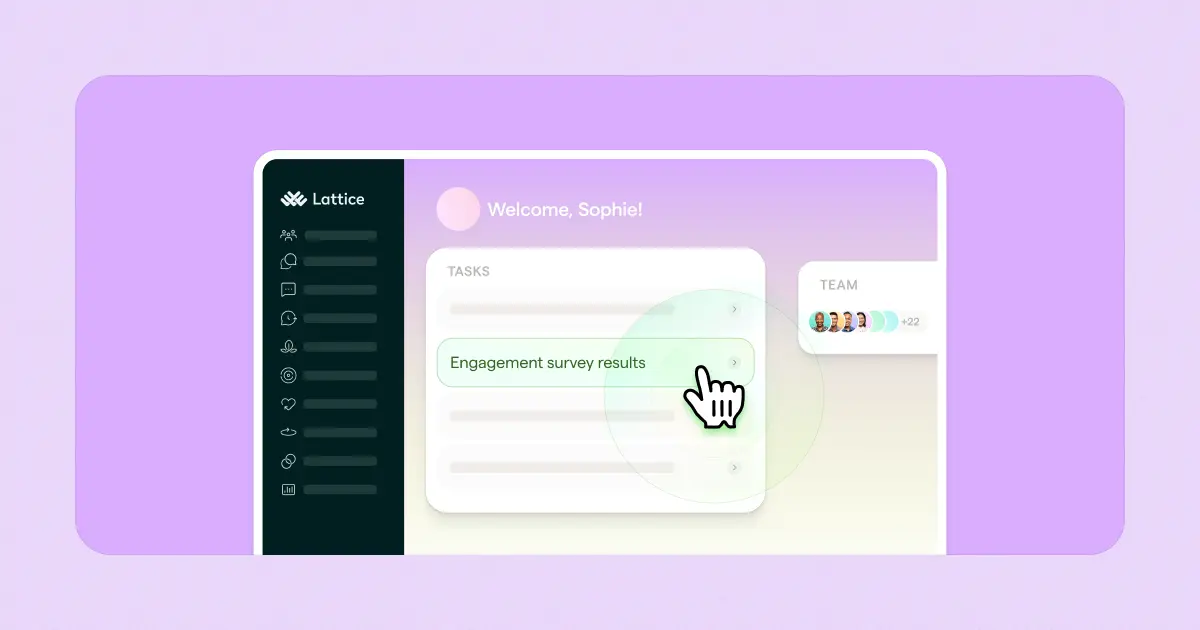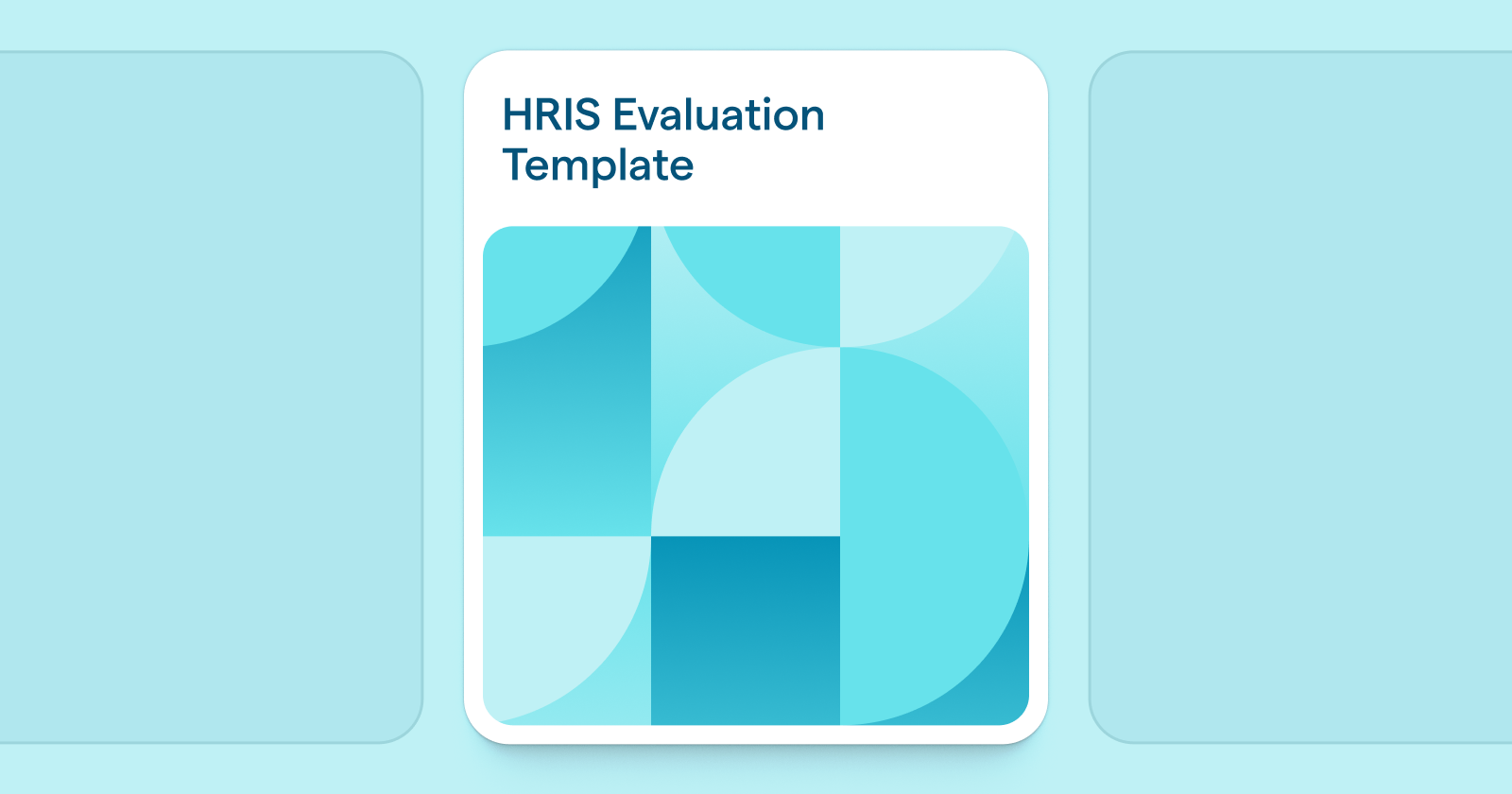When you’re trying to nurture sustainable, scalable growth in your small business, HR responsibilities can fall to the bottom of your to-do list. When you’re trying to keep the lights on, it’s easy to focus on revenue-generating activities rather than people operations.
But doing so is a risky move. Letting HR management become an afterthought increases liabilities across the business, from regulatory incompliance to poor employee engagement — risks that only grow alongside your business.
Having a comprehensive HR tool can transform your approach to people operations. Imagine having a solution that prompts and guides you through HR processes, reminds you of filing deadlines, auto-runs workflows, and serves as a secure, centralized place for all your HR needs.
At Lattice, we get that you don’t have a lot of time to spend on HR, whether it's managing human resources or navigating the numerous HR software solutions on the market. To streamline your research and selection, we created a guide to take the guesswork out of choosing the right HR platform for your small business needs.
{{rich-takeaway}}
Benefits of Using HR Software for Small Businesses
Sometimes it’s because of a lack of capital, other times it’s a bandwidth issue, but small business owners are often left managing critical business functions themselves. Many owners just don’t have the time required to make the hire or vet and source a software solution. But while managing HR manually may seem cost-effective at first, over time it eats away at productivity, accuracy, and even employee satisfaction, all costing money in the long run.
Plus, managing HR via Excel spreadsheets and inboxes makes for frustrating, complex workflows where information is misplaced, deadlines are forgotten, and abiding by strict filing requirements falls to the individual managing HR — you.
Adopting an HRIS transforms the way your business handles people operations to create efficiency and ensure you’re well-positioned for growth.
Saves Time and Reduces Busywork
Time is probably your most valuable resource. By using an HRIS, you’ll shrink the manual hours spent on onboarding, payroll, or reporting down to a few clicks. Instead of chasing down forms or manually entering time sheets or PTO requests, the system automates these workflows so you can shift your attention from rote administrative tasks to the things that actually grow your business.
Supports Better Compliance With Fewer Errors
Even small mistakes in payroll or recordkeeping can create real problems, whether it's hefty compliance fines or frustrated, distrustful employees. HR software minimizes those risks by ensuring you have the right, up-to-date information stored in a safe place. Tax filings, employee records, and benefits information are handled automatically, and alerts help ensure you don’t miss filing deadlines or other compliance requirements.
Offers Employees a Better Experience
Employees overwhelmingly want the ability to manage their requests, updates, and changes to forms. With self-service portals, they can update their own information, submit time-off requests, or download documents like pay stubs or tax forms without having to wait on you or their manager.
Helps You Make Smarter, Data-Driven Decisions
Don’t think of data analytics as something reserved for big corporations. Small businesses often operate on limited funds, which means making strategic decisions based on good data is all the more important.
HR software takes information across the business and turns it into insights, so you can make more strategic decisions about hiring, scheduling, and promoting. With a great HRIS, instead of guessing about turnover trends or PTO usage, you’ll have hard data to give you an accurate picture of what’s happening with your workforce.
{{rich-highlight-1}}
Sets the Stage for Growth and Scalability
You may not need a full suite of people operations features and functionality just yet, but the best HRISs scale with your business. You can start small, using the system to manage core needs like payroll and recordkeeping, and add more sophisticated tools, like those for performance management, engagement, or analytics as your business expands. This flexibility keeps you from having to switch platforms every few years, saving you time, money, and stress as you scale.
Reduces Risk
Risk shows up in lots of small, costly ways like a missing I-9, a misclassified contractor, an outdated handbook, or sensitive employee data stored in the wrong place. An HRIS helps close those gaps.
Centralized document storage means policies, signed acknowledgments, and audit trails live in one system, so when questions come up, you have the record. Role-based permissions keep sensitive data limited to the right people, while workflows cut down on the chance that steps get missed during hiring, leave, or employee departure. Alerts and checklists keep you aligned with current federal and state rules, even when compliance requirements change.
The Best Type of HR Software for Small Businesses
An HRIS gives you a single place to manage the most essential HR tasks, including onboarding, time tracking, and document storage. In this way, an HRIS acts as the central nerve of your HR functions, helping you to:
- Reduce the need for manual data entry (and reduce the chance for errors).
- Remain compliant with various employment laws and recordkeeping requirements.
- Improve HR document and process visibility across your company, even without a dedicated HR person.
- Position your small business for growth by having scalable workflows ready to go.
Must-Have HR Software for Small Businesses
When you’re running a small business, you don’t have time or bandwidth to cross-check the software features needed to handle all your HR tasks. And unless you’ve worked as an HR professional, you may not even know what the features you need are.
When selecting HR software, prioritize platforms that offer:
Essential HR Features
- Employee directory and records: Provides a single, secure, centralized place to store employee information
- Time-off management and scheduling: Simplifies PTO requests and ensures appropriate coverage for shift work
- Onboarding and offboarding workflows: Automate all the required paperwork when employees are joining or leaving your company
- Performance management and feedback exchange: Streamlines performance reviews, goal setting, and feedback
Payroll and Benefits Administration
- Tax filing and direct deposit
- Benefits enrollment and tracking
Intuitive User Experience
- Easy-to-navigate
- Mobile-friendly
- Self-service so employees can manage their own requests, documents, etc.
Integrations
- Other business systems, like an applicant tracking system (ATS) or payroll
Affordability and Scalability
- Transparent pricing (no surprises!)
- Growth-friendly plans that allow you to add employees
Telltale Signs It’s Time to Invest in HR Software
1. You’re spending too much time on admin.
When everyday tasks like running payroll, tracking PTO, or onboarding new hires start taking up hours each week, it’s a sign your processes aren’t working. HR software centralizes these tasks, streamlining your people operations and freeing up your time to focus on growing the business.
⏰ Takeaway: If HR admin is eating into time that should be spent growing your business, it’s time for an upgrade.
2. You don’t know what is stored where.
Raise your hand if you’re juggling multiple spreadsheets, storing documents in various folders, or digging through email chains to find employee information.
There’s a better way. A centralized HR system ensures your data is accurate, organized, and in one place. When questions arise, you’ll have what you need to respond or demonstrate compliance.
📝 Takeaway: If your “system” is multiple spreadsheets and sticky notes, it’s time to streamline.
3. Payroll or compliance mistakes are happening.
If you’re running payroll late, missing filing deadlines, or misplacing tax forms, it’s time to invest in an HRIS. “Small” errors in payroll or tax filing add up quickly and become big problems, whether with regulators or your workforce.
HR software automates calculations and keeps detailed records, reducing the chance of mistakes and helping you stay on top of changing compliance requirements.
🎯 Takeaway: If errors or compliance risks are keeping you up at night, HR software provides much-needed peace of mind.
4. You don’t have clear data or reports.
Making decisions without reliable data is challenging! If you’re guessing when to hire, unsure of your turnover rate, or struggling to track PTO accurately, it may be time to consider a system that gives you clear, real-time insights into your workforce.
📊 Takeaway: When you can’t measure what’s happening, it’s time for an HRIS.
5. Remote or hybrid work is getting complicated.
Managing HR tasks gets more complex when your team isn’t in the same place. If you’re struggling to coordinate schedules, share policies, or track leave for remote or hybrid employees, a cloud-based system makes these processes easier and more consistent.
📌 Takeaway: If location is getting in the way of efficiency, an HR platform bridges the gap.
6. Growth is creating chaos.
If you’ve noticed that the time spent managing people operations has grown alongside your headcount, it’s probably time for a new way. When onboarding isn’t standardized, documents get misplaced, and processes are hard to track.
📢 Takeaway: If growth feels overwhelming, the right HR platform will help you scale smoothly and confidently.
{{rich-highlight-2}}
How We Curated This List for Small Business Needs
Our list is built for small business owners, not HR departments at big companies with endless budgets. We know you’re looking for tools that are intuitive to use, affordable, and scalable as you grow.
More than anything, we understand you’re looking for a tool that gets the job done, not creates another task you have to manage.
We Came Up With This List By:
1. Prioritizing Small Business Needs
We started by mapping the pain points small businesses face, like:
- Limited headcount
- Lack of standardized practices
- Limited time and resources for admin
- Compliance risks that stem from manual processes or documentation practices
- The need for tools that integrate
2. Balancing Features With Budget
Small businesses don’t have the same needs as corporations. We get that. We evaluated HR software by weighing:
- Core HR and payroll for everyday operations
- Integrations for efficiency
- Mobile-friendly interfaces for teams on the go
- Employee self-service for time savings
- Recruiting and scheduling tools, where applicable
- Analytics and performance tracking to support growth decisions
Platforms that combined value with a strong feature set ranked higher on our list.
3. Positioning You for Growth and Scalability
Choosing the right HR software isn’t just about solving problems today. The best platforms will grow with your business. A system that starts as a simple payroll processor but evolves into a full HRIS — with performance management, advanced analytics, and expanded integrations — means you won’t have to repeat the evaluation process in a few years.
The Best HR Software for Small Businesses
BambooHR
BambooHR is an out-of-the-box HR software provider for small to midsize businesses that spans core HR, payroll, time tracking, and benefits management all in one place. The platform also offers employee self-service, performance reviews, and an ATS.
⭐ G2 rating: 4.4/5
Key Features
- Recruitment suite, including an ATS and new hire employee onboarding workflows
- Pre-built reports and automated reporting workflows
- Employee satisfaction, employee Net Promoter Score (eNPS), and wellbeing tracking
- Integrations include: Oyster, Checkr, Deel, Lattice, Travitor, and Spark Hire
Pros
- Integrated user experience
- Easy implementation and roll-out
Cons
- Limited customizations and ability to build bespoke workflows
- Limited flexibility around different types of employee classification, with one reviewer noting that contracted employees were not reflected in the company directory
Reviews
- “Our employees love how easy it is to use, especially the self-service features that let them manage their personal information with ease.” – Small business director of human resources, G2
- “I wish there had been more transparency around the payroll add-on. I was surprised to find out that something as routine as having a state tax notice reviewed came with an additional charge. It’s the kind of detail I would’ve appreciated knowing up front.” – Small business admin and HR manager, G2
Pricing: Pricing starts at $10 per employee per month (PEPM) for core functionality.
Gusto
Gusto is a payroll-focused HR platform that helps small businesses manage core administrative tasks like paying employees, handling taxes, and offering basic benefits.
⭐ G2 rating: 4.6/5
Key Features
- Automated payroll with federal, state, and local tax filing
- Direct deposit and contractor payment
- Benefits administration, including health insurance and retirement plans
- Onboarding tools for new hires
- Time tracking and PTO management
- Integrations with accounting platforms like QuickBooks and Xero
Pros
- Straightforward setup and intuitive interface
- Strong support for small business payroll compliance
- Responsive customer support
Cons
- As essentially a payroll software, Gusto has limited advanced HR features, such as analytics or talent management.
- Pricing can increase as teams grow or add additional services.
Reviews
- “In a pinch, I was able to fully set up Gusto in less than an hour and run payroll the same week.” – Small business owner, G2
- “Customer support can be slow to respond during busy times like year-end or tax season. Reporting features could also be more customizable for businesses that want deeper insights.” – Small business office engineer, G2
Pricing: Pricing starts with a base fee of $49 per month, plus $6-22 PEPM depending on the modules used.
Deel
Deel is an all-in-one HRIS designed for global and remote workforces, distinguished by its in-house employer of record (EOR) system, which enables customers to hire and pay talent worldwide. Deel doesn’t have native talent management or performance management features, although it does integrate with other HR platforms.
⭐G2 Rating: 4.8/5
Key Features
- Built-in EOR system to support global hiring
- International payroll
- Contractor management to hire remote contractors and freelancers
Pros
- Ease of use
- Streamlined payments
Cons
- Customer service delays
- High fees
Reviews
- “The platform is incredibly user-friendly, and onboarding a new team member, whether they are an employee or a contractor, is a remarkably fast and simple process.” – Mid-market software engineer, G2
- “The most pressing issue is the lack of a live chat or immediate help center. When an urgent payroll or compliance question arises, having to submit a ticket and wait for an email response can cause critical delays.” – Mid-market software engineer, G2
Pricing: Pricing starts at $20 PEPM for basic HR features. Payroll, Compensation, Workforce Planning, and all of their IT features are additional costs. It’s best to speak with sales for an accurate understanding of pricing.
Greenhouse
Greenhouse is a well-known applicant tracking system that helps small and growing businesses streamline recruiting and hiring processes. While it primarily focuses on talent acquisition, Greenhouse also offers basic HR features and integrations to support onboarding and employee management.
⭐G2 Rating: 4.4/5
Key Features
- Applicant tracking with customizable hiring pipeline
- Automated job posting to multiple job boards
- Candidate scoring, collaboration, and interview scheduling tools
- Onboarding workflows for new hires
- Integrations with HRIS, payroll, and productivity platforms
- Reporting and analytics for hiring metrics
Pros
- Highly customizable workflows for recruiting teams
- Strong analytics and reporting tools for data-driven hiring
- Extensive integration library with HR, payroll, and collaboration tools
Cons
- Primarily a recruiting platform; lacks deeper HRIS or payroll capabilities
- Can feel complex for small teams with limited recruiting expertise
- Cumbersome and unintuitive interface
Reviews
- “Greenhouse keeps our hiring process organized and makes it easy for the team to collaborate.” – Small business recruiter, G2
- “One downside to Greenhouse is that, while it's feature-rich, it can sometimes feel a bit overwhelming for smaller teams or companies that don’t have a dedicated HR or recruiting function.” – Service desk engineer, G2
Pricing: Greenhouse uses a quote-based pricing model, with costs varying depending on company size, feature needs, and number of open roles.
{{rich-highlight-3}}
HiBob
HiBob is a performance management platform designed to help improve productivity, engagement, and employee retention. Top features include 360-degree performance reviews, ongoing one-on-ones, goal tracking, and customizable reporting tools to help businesses understand and invest in their employees.
⭐ G2 Rating: 4.5/5
Key Features
- HR Workflows automate onboarding, offboarding, promotions, and policy updates for consistency and efficiency.
- Engagement tools make it easy to use surveys, feedback tools, and recognition features to track and boost engagement.
- Performance management features support goal setting, structured reviews, and ongoing one-on-ones.
Pros
- Intuitive, user-friendly platform
- Helpful and responsive customer service
- Features that support continuous employee communication
Cons
- Performance reviews don’t support weighted goals.
- Customization options may be too limited for organizations with complex needs.
- Frequent platform design changes can leave employees confused.
Reviews
- “I found HiBob relatively easy to implement at the start and the support we received from the team helped me get buy-in from different parts of the business so it was fairly well adopted.” – Verified user, G2
- “Additional cost for ‘add-ons’ such as training, payroll, etc. modules. This is troublesome for us as a small business of under 50 people as I cannot get the funding for it.” – Small business HR support officer, G2
Pricing: Pricing is quote-based, with costs varying depending on company size, feature needs, and number of open roles. User reviews place pricing within the $16-25 PEPM range.
Culture Amp
Culture Amp is a “people and culture platform” designed to help companies understand engagement, evaluations, reviews, and goal tracking across their company.
⭐ G2 Rating: 4.5/5
Key Features
- Employee surveys to measure engagement, satisfaction, and culture health
- 360-degree feedback tools for continuous insights and peer recognition
- Performance evaluations with structured reviews and goal tracking
- Reporting and analytics for actionable workforce insights
- Integrations with HRIS, payroll, and productivity platforms
Pros
- Actionable insights on engagement, performance, and retention
- Support for set-up and launch
- Survey templates that make it easy to check in with employees on a range of topics
Cons
- Importing past reviews is challenging.
- Reporting tools are not user-friendly.
- Administrative functions are limited.
Reviews
- “I appreciate being able to use the tool to generate valuable insights through surveys.” – Mid-market human resources coordinator, G2
- “Although the interface is user-friendly, the depth of features means there can be a learning curve for new users.” – Mid-market assistant manager HR administration, G2
Pricing: Pricing is believed to be around $5-$12 PEPM. Exact pricing is quote-based and depends on the number of employees, product chosen, and service tier.
Rippling
Rippling is a human capital management (HCM) solution sitting at the intersection of HR, IT, and finance. Rippling offers payroll, HR, and IT platforms, although performance management tools can be added to its core functionality for an additional fee. These tools include reviews, goal setting, calibrations, and detailed reporting.
⭐G2 Rating: 4.8/5
Key Features
- HRIS
- Payroll
- Device/app provisioning
- Workflow automation
Pros
- User-friendly, intuitive interface
- Strong integrations with a wide range of HR tech tools
- Streamlined onboarding modules that seamlessly align IT and HR tasks
Cons
- Performance management tools are not included in the core platform.
- Support is limited to chat.
- Pricing may be high for small to midsize businesses.
- There are many hidden costs, which means fees add up. “Any semi-complicated reports cost extra. Any automation/notifications cost extra,” said one people manager at a mid-market company.
Reviews
- “I like Rippling’s easy and user-friendly interface, making it intuitive for setting up and daily use.” – Mid-market design analyst, G2
- “Some integrations feel less polished than the core HR modules, and customer support response times can be inconsistent during peak issues.” – Mid-market designer, G2
Pricing: According to software and service review site Business.com, pricing starts around $8 per user per month, plus a $40 monthly platform fee.
Paycor
Paycor is a payroll and HR platform built for small and midsize businesses that need reliable compliance support and workforce management tools.
⭐ G2 Rating: 3.9/5
Key Features
- Payroll processing with automated tax filing
- Time and attendance management
- Benefits administration with enrollment tools
- Compliance resources and alerts
- Workforce reporting and analytics
Pros
- Comprehensive payroll and compliance functionality
- Mobile-friendly interface for employees and managers
- Helpful customer support for setup and troubleshooting
Cons
- Interface and reporting tools can feel complex for new users.
- Customization options are limited compared to other platforms.
Reviews
- “Additionally, Paycor’s reporting tools give us valuable insights into workforce trends and labor costs, supporting strategic decision-making.” – Verified user, G2
- “In the beginning, their support was great; I could reach out with questions and get helpful responses quickly. However, after COVID, the quality of support noticeably declined.” – Mid-market HR manager, G2
Pricing: Pricing is quote-based, but is estimated to range between $5 and $14 PEPM, plus monthly base fees of $99-199, depending on the software and services selected.
Workable
Workable is a recruitment-focused platform that offers basic human resource management tools alongside its ATS. It is widely used by small businesses with active hiring needs.
⭐ G2 Rating: 4.5/5
Key Features
- Applicant tracking system for recruiting and candidate management
- Job posting to multiple boards simultaneously
- Interview scheduling and collaboration tools
- Time-off management
- Basic employee recordkeeping
Pros
- User-friendly interface for hiring teams
- Streamlined recruiting and candidate communication
- Transparent ATS pricing
Cons
- Workable has limited HR functionality compared to dedicated HRIS platforms.
- Some features require integrations with third-party tools.
- The AI model’s rating of candidates could be more accurate.
Reviews
- “The platform allows for complete automation of our hiring process, including offer letters, resulting in a more efficient workflow and a consistently positive candidate experience.” – Small business head of people and culture, G2
- “Not great on the HR side - quite basic. But in terms of hiring it’s good. AI assessment of people’s CVs often wrong, however, so have to ignore that rating.” – Small business associate operations manager, G2
Pricing: Pricing starts at $299 per month for its recruiting services for companies with up to 20 employees. Core HR services like HRIS, time tracking, and payroll preparation are available as a bundled add-on.
Lattice, the Best Small Business HR Software
If you’re part of a small or midsize business, Lattice HRIS may just be your best option. As an AI-powered people and performance management platform, Lattice transforms how your company approaches all elements of HR, from administrative tasks like storing employee records to managing employee performance, engagement, and development.
⭐G2 Rating: 4.7/5
Lattice Key Features
Unified Employee Data
Lattice HRIS creates a single source of truth for all your employee data. With a centralized pool of employee information, you’ll find it easy to spot trends across the employee lifecycle, like turnover patterns, engagement levels, and performance outcomes.
Native Integration With Talent Management Tools
Instead of juggling multiple platforms and logins, you can manage all of your HR programs in Lattice’s intuitive, user-friendly interface. With Lattice, performance reviews, goal tracking, manager one-on-ones, learning and development programs, and more all live in one place, creating a more connected and less fragmented HR experience for both you and your team.
Streamlined Payroll and Finance Alignment
With Lattice Payroll, you can integrate payroll directly into your HRIS, ensuring clean, consistent data across teams.
Prefer to keep your current provider? Lattice integrates seamlessly with existing payroll systems for maximum flexibility to enable finance and HR to stay in sync without extra manual work.
An Employee-First Experience
Legacy HRIS platforms were built for HR professionals and administrators, not for employees. Lattice has always led with an employee-centric design that’s intuitive and easy to navigate (for administrators, too). It empowers your team to handle onboarding, time-off requests, time tracking, and document management on their own — saving your HR lead (or you, the business owner) hours of repetitive admin work.
Flexibility and Scalability for Growing Teams
As a growing small business, it’s likely your HR needs today won’t be the same as your needs a year from now. That’s why Lattice HRIS is highly customizable — you can start with the essentials and add advanced features as you grow. With configurable workflows and permissions and deep integrations with tools like Greenhouse, Gusto, and Lever, Lattice helps you build a streamlined HR tech stack without the complexity or cost of a patchwork approach composed of many solutions.
Key Features
- Unified Employee Data: Records for demographics, performance, engagement, and retention are all centralized.
- Customizable Permissions: Flexible access controls for HR, managers, and employees
- Talent Management Integration: Performance reviews, goal setting, and engagement tools all live in one system.
- Automated Workflows: Workflows help streamline tasks like onboarding, approvals, manager check-ins, and documentation.
- Scalable Platform: You can start with core HR and add payroll, performance, or engagement as you grow.
- Payroll Flexibility: Use Lattice Payroll or integrate with existing payroll providers.
- Deep Integrations: Lattice works with Greenhouse, Lever, Sequoia, Workday, Personio, Gusto, and more.
Pros
- Centralized platform for HR, performance, and engagement in one system
- Unified employee data for integrated analytics and reporting
- Native integration with Lattice’s talent management tools to avoid a fragmented HR tech stack
- Highly flexible workflows, reports, and permissions to match your processes
- Employee-friendly interface that simplifies self-service tasks like onboarding and PTO
- Deep integrations with popular tools like Greenhouse, Lever, Gusto, and Workday
Cons
- Training may be needed to make the most of all the features.
- Additional modules (like Payroll or advanced analytics) can increase cost as you scale.
Pricing: Pricing starts at $10-11 PEPM, depending on your needs. Visit our pricing page for more details.
Comparison of Top HR Software for Small Businesses
Choosing the right HR software can transform how your small business manages people operations, freeing up time, reducing risk, and creating a better experience for you and your employees.
Whether you need help streamlining payroll, improving performance management, or gaining actionable insights from your data, Lattice HRIS lays the foundation for scalable growth.
Ready to simplify your small business HR processes? Request a demo of Lattice HRIS today.

🆕 Take a Free Lattice Tour
Reading about tools is a start, but nothing beats getting your hands on the real thing. Give Lattice a whirl.
▶️ Getting Buy-In for Tech Purchases
HR tech buying decisions impact the whole company. Listen to HR experts weigh in on who to loop into the decision.
Key Takeaways:
- A human resources information system (HRIS) saves small businesses time by automating payroll, onboarding, and other rote or repetitive tasks.
- A centralized employee data hub reduces compliance risks and improves accuracy across processes.
- Self-service tools empower employees while reducing admin burdens on owners and managers.
- Data-driven insights help leaders make smarter decisions about hiring, retention, and growth.
- Scalable platforms grow with your business, eliminating the need for frequent software changes.
- Choosing the right HRIS improves efficiency, engagement, and the overall employee experience.









